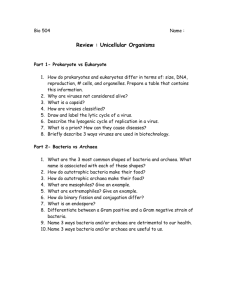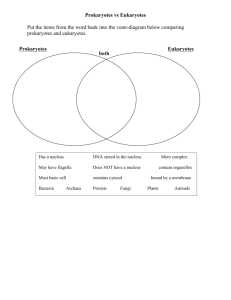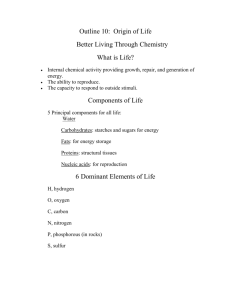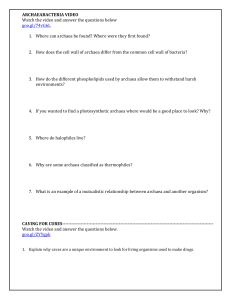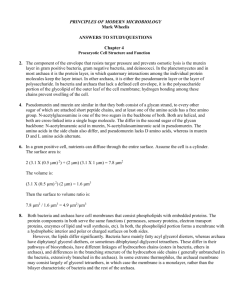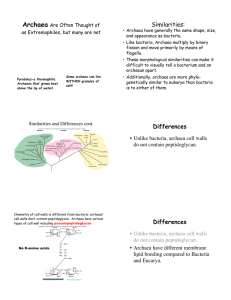2.2- Comparing Bacteria & Archaea
advertisement
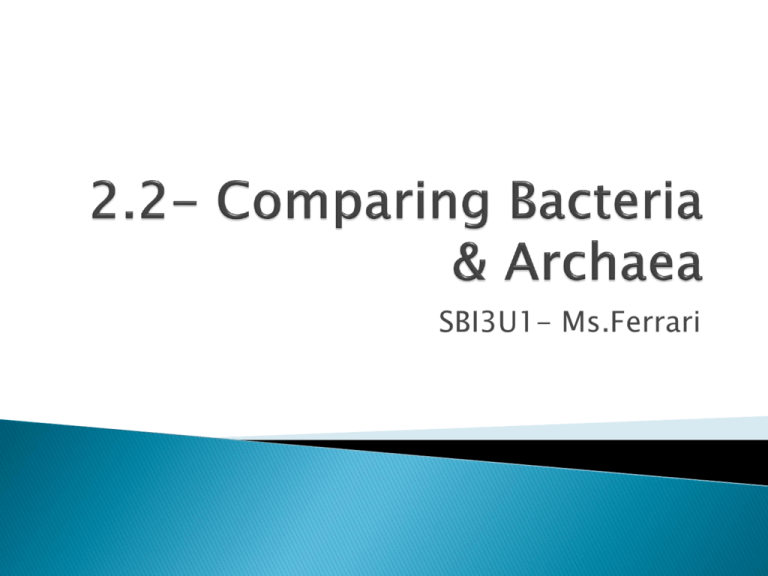
SBI3U1- Ms.Ferrari Recall: Prokaryotes are represented by 2 domainsBacteria, Archaea Therefore we can compare and contrast Bacteria and Archaea by looking at the following: 1) Type of cell ( eukaryote? Prokaryote? ) 2) Morphology ( shape) 3) Aggregation ( how are cells grouped together?) 4) Nutrition 5) Habitat 6) Reproduction • Cell Type: Both are prokaryotic Morphology: similar shape- cocci (spheres), bacilli (rods), and spirilli ( spiral cells) Nutrition: both either consume other organisms or use inorganic compounds Habitat: Both are found in extreme environments; more archaea live in extreme habitats (extremophiles), while more bacteria live in moderate habitats (mesophiles) Reproduction: binary fission BACTERIA ARCHAEA 1) shaped like pyramids, cubes, or rods with star cross-sections, 2) Some are photosynthetic, 1) shaped like plates or rectangular rods 3) live anaerobically in human guts; 3)live anaerobically in cattle guts. 2) Some aare methanogenetic (produce methane gas as byproduct). Most common forms in both bacteria and archaea are spheres and rods. Spherical forms are called cocci Rod forms are called bacilli Spiral forms are called spirilli cocci bacilli spirilli Chapter 2: Diversity: From Simple to Complex Section 2.2 Thermophiles live in hot springs and deep sea vents, enduring temperatures over 100ºC. Example: Archaea Methanopyrus Acidophiles live in volcanic craters and mine drainage lakes, enduring pH levels lower than 3. Example: Archaea Picrophilus Halophiles live in salt lakes and inland seas, enduring salt concentrations above 20%. Example: Archaea Halococcus Binary fission is asexual reproduction. Both domains lack a nucleus therefore the only way to reproduce is asexually. UNIT 1 Chapter 2: Diversity: From Simple to Complex Section 2.2 In less favorable conditions, DNA can be exchanged instead of reproducing by binary fission. Conjugation= one cell links to another by a pilus (tube) and transfers a copy of some or all of the chromosomes. Bacteria that will stain because they contain a thick protein layer on their cell wall are Gram-positive (become purple) Bacteria that will not stain because they have a thin protein layer are Gram-negative (become pink). A)Clostridium botulinum causes food poisoning B)Streptococcus pyogenes causes strep throat C)Streptococcus mutans causes tooth decay Read and make notes 2.1 Pgs.59-68 Complete pg. 66 Q# 1, 2, 4, 5, 8, 11


